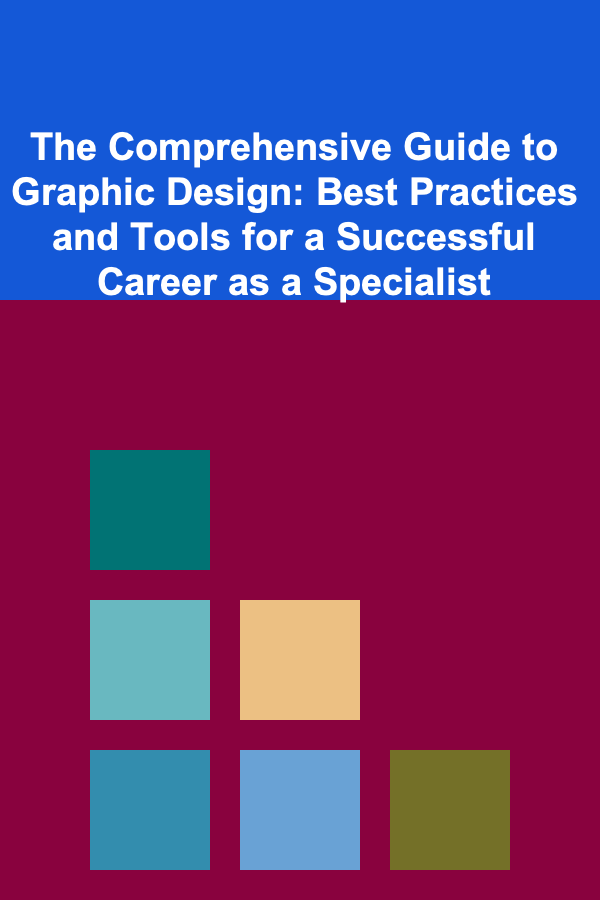
The Comprehensive Guide to Graphic Design: Best Practices and Tools for a Successful Career as a Specialist
ebook include PDF & Audio bundle (Micro Guide)
$12.99$6.99
Limited Time Offer! Order within the next:

Graphic design is more than just creating visually appealing artwork. It's a profession that blends creativity, technical skills, and a deep understanding of communication to craft designs that resonate with an audience. Whether you're designing logos, websites, advertisements, or print media, effective graphic design can elevate a brand, tell a compelling story, and drive action.
For aspiring designers or professionals looking to sharpen their skills, this guide offers actionable advice on best practices and essential tools for building a successful career in graphic design.
Understanding the Role of a Graphic Designer
At its core, graphic design is about solving problems with visual communication. A graphic designer's role involves more than just making things look good. It's about understanding the client's needs, the target audience, and the message to be conveyed.
Key Responsibilities of a Graphic Designer:
- Branding: Establishing a visual identity that reflects the essence of a business, product, or service.
- Web and User Interface Design (UI): Creating visually appealing layouts and interfaces for websites and apps.
- Print Design: Designing tangible materials such as brochures, posters, business cards, and packaging.
- Marketing Materials: Creating eye-catching promotional assets like banners, ads, and social media content.
- Typography: Choosing and arranging typefaces to enhance readability and visual appeal.
Soft Skills for Success:
- Creativity: The ability to generate new, innovative ideas and think outside the box.
- Communication: Graphic designers must understand the client's vision and communicate design decisions clearly.
- Attention to Detail: Every aspect of a design---color, font, spacing---must work together cohesively.
- Time Management: Meeting deadlines is essential, especially when working with multiple clients or projects simultaneously.
Essential Design Principles
Before diving into tools and techniques, it's essential to grasp the fundamental principles of design. These principles serve as the foundation upon which successful designs are built.
Key Design Principles:
1. Balance
Balance refers to the distribution of visual weight in a design. It ensures that elements within the design feel evenly distributed, creating harmony.
- Symmetrical Balance: Elements are mirrored on either side of a central axis.
- Asymmetrical Balance: Elements are balanced through contrast, color, and size rather than symmetry.
2. Contrast
Contrast is used to create visual interest and emphasize particular elements. This could be through the use of colors, sizes, textures, or typography.
3. Alignment
Alignment ensures that elements on the page are visually connected, making the design feel organized. Proper alignment avoids disjointed designs and gives the viewer a sense of order.
4. Repetition
Repetition involves the reuse of elements such as colors, shapes, or fonts throughout a design. It creates consistency and helps tie the design together.
5. Proximity
Proximity refers to the placement of related elements close to each other. Grouping similar items together helps the viewer understand the relationships between elements.
6. White Space (Negative Space)
White space isn't just empty space---it's an important design element that enhances readability, prevents clutter, and allows other design elements to breathe. It's crucial for achieving balance and clarity.
7. Hierarchy
Hierarchy guides the viewer's eye through the design in a specific order. By varying the size, color, or positioning of elements, designers can prioritize the most important information.
Best Practices in Graphic Design
Mastering the technical side of graphic design is important, but implementing best practices ensures that your designs not only look good but also function well for their intended purpose.
1. Understand Your Audience
Every design decision should be made with your target audience in mind. Whether it's a corporate client or a young tech startup, understanding the preferences, tastes, and needs of the audience will guide your design choices.
Actionable Tip:
Create buyer personas---detailed descriptions of the target users---for better alignment of your designs with the intended audience.
2. Keep It Simple
A common trap in graphic design is the urge to fill every inch of space. However, simplicity often leads to the most effective designs. Less is often more. A clean, minimalistic design enhances focus and readability.
Actionable Tip:
When in doubt, remove elements. Always ask yourself if an element adds to the overall communication or if it's just filling space.
3. Consistency Across Designs
Consistency builds trust and recognition. Whether you're working on a website, a set of advertisements, or packaging, maintain visual consistency by using the same color schemes, fonts, and design elements.
Actionable Tip:
Create design templates that establish brand guidelines. This includes approved fonts, colors, image styles, and logos, ensuring consistency across all design pieces.
4. Optimize for Different Platforms
In today's digital world, designs need to be adaptable across multiple platforms and devices, including desktops, tablets, mobile phones, and print materials. Always keep in mind how your designs will appear on various screens or in physical formats.
Actionable Tip:
For web designs, use responsive design principles to ensure your layouts adapt smoothly to different screen sizes.
5. Pay Attention to Typography
Typography isn't just about picking a nice font. It's about creating readable, legible, and aesthetically pleasing text that fits the design's overall tone.
Actionable Tip:
Use a maximum of two or three fonts to avoid visual clutter. Ensure that the font sizes are appropriate for the hierarchy of information---larger fonts for titles, smaller ones for body text.
6. Test and Get Feedback
Don't be afraid to experiment and revise your designs. Getting feedback from peers, clients, or even users can reveal areas for improvement and ensure the design communicates the intended message effectively.
Actionable Tip:
Present your designs in mockup formats (website or product mockups) so clients can visualize how they will look in real-world settings.
Tools Every Graphic Designer Should Know
Graphic designers rely on a combination of tools for creating and editing their designs. These tools help streamline workflows and ensure the final product meets professional standards.
1. Adobe Creative Suite (Photoshop, Illustrator, InDesign)
Adobe Creative Suite is the industry-standard toolset for professional designers. Whether you're working on vector graphics in Illustrator, photo manipulation in Photoshop, or page layouts in InDesign, these tools are essential for high-quality design work.
- Photoshop: Best for photo editing, web design, and raster graphics.
- Illustrator: Ideal for vector-based graphics such as logos, icons, and illustrations.
- InDesign: Excellent for page layout design, such as books, brochures, and magazines.
Actionable Tip:
Invest time in mastering Adobe tools, as they offer advanced features that can significantly enhance your workflow and output.
2. Canva
For less complex projects or when working with clients on a budget, Canva is a great web-based tool. It provides templates for social media posts, flyers, presentations, and more. While it may not have the advanced features of Adobe software, it's perfect for quick, simple designs.
Actionable Tip:
Use Canva for projects that require rapid turnaround time or for clients who want to make their own design edits.
3. Sketch and Figma
For digital product designers, especially those focused on web or app design, Sketch and Figma are fantastic tools. They offer user interface (UI) design features, prototyping, and collaboration tools, making them ideal for team-based projects.
- Figma: A cloud-based design tool that allows real-time collaboration, making it perfect for teams.
- Sketch: A vector-based design tool popular for creating user interfaces and websites.
Actionable Tip:
If you work as part of a design team, using tools like Figma can drastically improve your workflow by allowing real-time collaboration and feedback.
4. Procreate (for iPad)
For designers who prefer working on tablets, Procreate is a top choice for digital drawing and illustration. It's particularly popular with illustrators and designers looking to add hand-drawn elements to their work.
Actionable Tip:
Use Procreate to create custom illustrations or hand-drawn elements that can add a unique flair to your designs.
5. Affinity Designer and Affinity Photo
These are excellent alternatives to Adobe products. Affinity Designer is a vector graphic design tool, and Affinity Photo is perfect for raster graphics and photo editing. Both are known for their one-time purchase model, which can be more affordable than Adobe's subscription-based approach.
Actionable Tip:
Consider using Affinity tools if you're looking for a cost-effective option with similar functionality to Adobe products.
Building a Successful Career in Graphic Design
A successful career in graphic design requires more than just technical skills; it involves networking, staying current with design trends, and building a strong portfolio.
1. Build an Impressive Portfolio
Your portfolio is your ticket to landing new clients or a full-time job. It should showcase your best work and demonstrate the breadth of your design skills. Include case studies that explain your design process, not just the final product.
Actionable Tip:
Create an online portfolio using platforms like Behance or Dribbble. Ensure that it's easy to navigate and highlights the diversity of your design projects.
2. Networking and Marketing Yourself
In today's interconnected world, networking is crucial. Attend design conferences, participate in online design communities, and engage on social media platforms. Platforms like LinkedIn , Instagram , and Twitter are great for connecting with fellow designers, potential clients, and recruiters.
Actionable Tip:
Offer free resources or share your design knowledge through blog posts or tutorials to build your personal brand.
3. Stay Current with Trends
The design world is constantly evolving, and staying updated with the latest trends, tools, and techniques will help you remain relevant. Follow design blogs, attend webinars, and participate in design challenges to keep your skills sharp.
Actionable Tip:
Subscribe to design blogs like A List Apart or Smashing Magazine for the latest trends, tips, and tutorials.
4. Client Communication and Management
Working with clients involves not only understanding their design needs but also managing timelines, budgets, and revisions. Clear and proactive communication can prevent misunderstandings and ensure a smooth workflow.
Actionable Tip:
Set clear expectations upfront in terms of project scope, timelines, and feedback processes. Use project management tools like Trello or Asana to keep track of tasks and deadlines.
Conclusion
Graphic design is a dynamic and rewarding career that combines creativity, technology, and communication. By mastering design principles, best practices, and using the right tools, you can create impactful designs that connect with your audience and help businesses thrive. As you build your career, continue learning, experimenting, and refining your skills to stay ahead of industry trends and elevate your design expertise.

Becoming a Successful Content Marketing Manager: Tips for Driving Brand Growth
Read More
How to Create a Checklist for Monitoring Post-Migration Analytics
Read More
How to Pet-Proof Your Kitchen for Safety
Read More
How to Use Deep Learning to Build Scalable Passive Income Models
Read More
How To Learn a Language Through Music
Read More
How to Build a Wilderness First Aid Kit: A Complete Checklist
Read MoreOther Products

Becoming a Successful Content Marketing Manager: Tips for Driving Brand Growth
Read More
How to Create a Checklist for Monitoring Post-Migration Analytics
Read More
How to Pet-Proof Your Kitchen for Safety
Read More
How to Use Deep Learning to Build Scalable Passive Income Models
Read More
How To Learn a Language Through Music
Read More